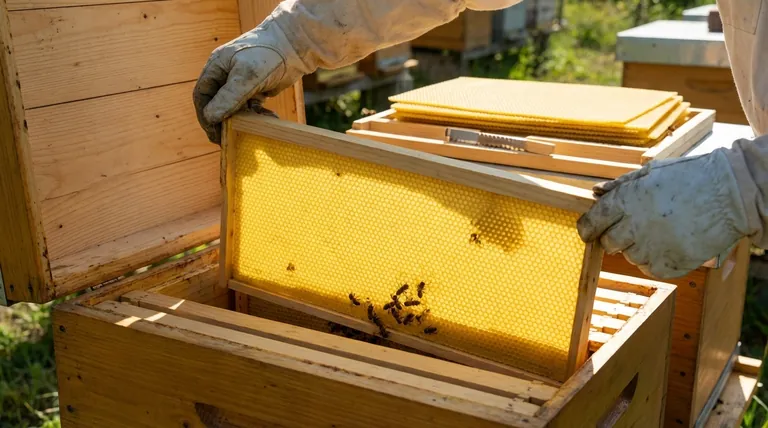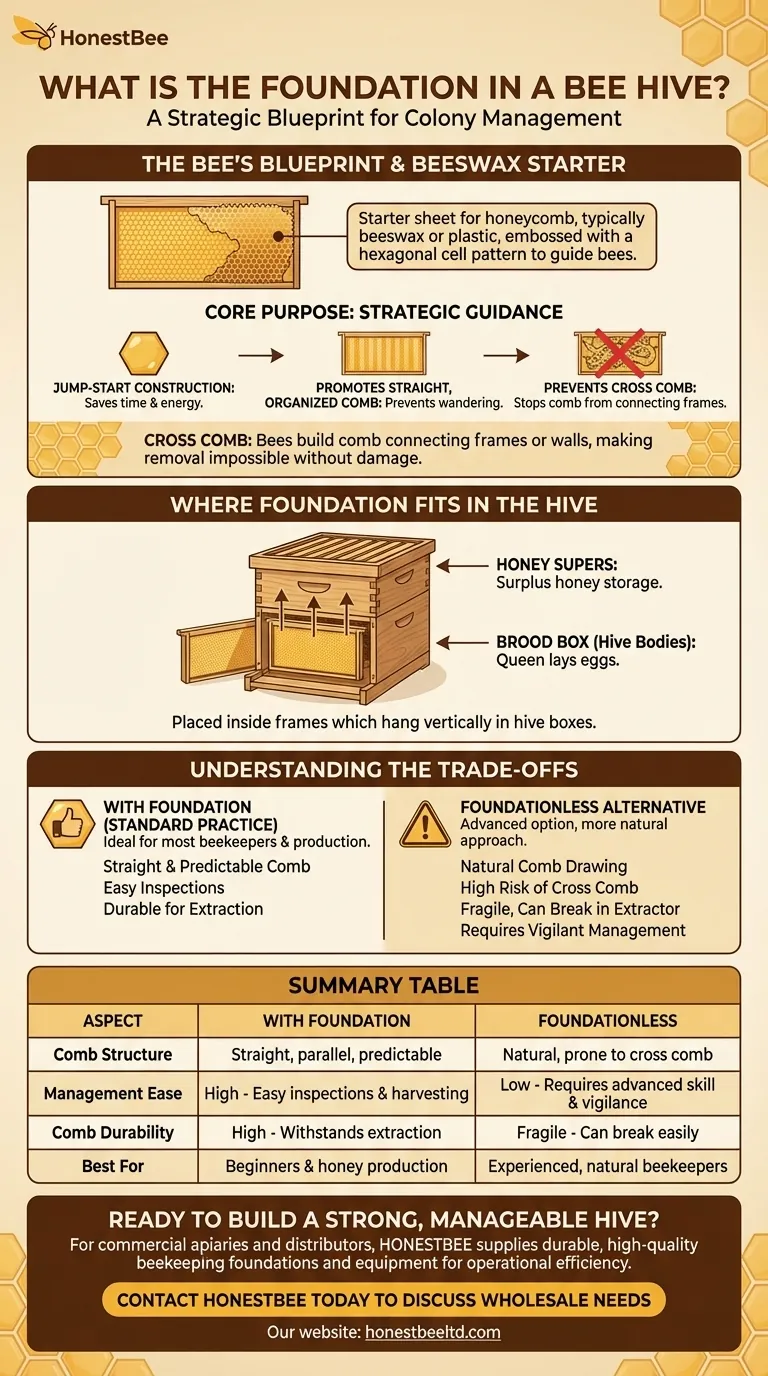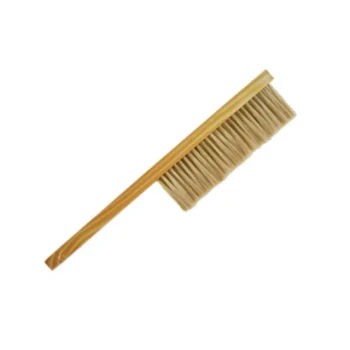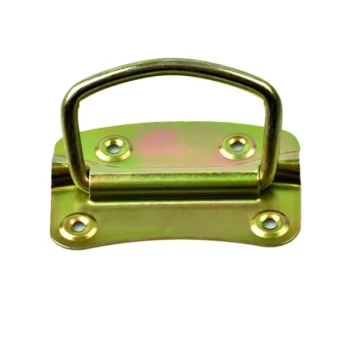In beekeeping, foundation is a starter sheet for honeycomb placed within a frame. It is typically a thin sheet of beeswax or plastic that has been embossed with the hexagonal cell pattern that bees naturally use. This pattern acts as a guide, encouraging the bees where and how to build their wax comb.
The core purpose of hive foundation is not merely to provide a base for comb, but to guide the bees' natural construction. This strategic guidance is what makes hive inspections, management, and honey harvesting efficient and predictable for the beekeeper.

The Strategic Role of Foundation
A sheet of foundation is a simple tool, but it solves a significant engineering problem for both bees and beekeepers. It provides a stable and predictable structure for the entire inner workings of the hive.
A Blueprint for the Bees
The embossed hexagonal pattern on the foundation gives the bees a clear starting point. This jump-starts the comb-building process, saving the colony significant time and energy resources.
Promoting Straight, Organized Comb
Without guidance, bees will build comb wherever they see fit. Foundation encourages them to build straight, parallel combs within the confines of the removable frames provided by the beekeeper.
Preventing "Cross Comb"
Cross comb occurs when bees build comb that connects multiple frames together or attaches comb to the hive walls. This makes it impossible to remove a single frame for inspection without tearing the comb, destroying brood, and spilling honey, creating a significant management problem. Foundation is the primary tool used to prevent this.
Where Foundation Fits in the Hive
Foundation does not exist in isolation; it is one part of an integrated system designed for hive management.
Inside the Frame
A sheet of foundation is installed in the middle of a wooden or plastic frame. These frames are designed to be hung vertically inside the hive boxes, perfectly spaced apart.
Frames Live in the Boxes
The frames containing foundation are placed inside the main boxes of the hive. These include the deeper brood boxes (or "hive bodies") where the queen lays eggs, and the shallower honey supers where surplus honey is stored.
Understanding the Trade-offs
While using foundation is the standard practice, it's important to understand the alternatives and why the standard exists.
The Case for Using Foundation
For most beekeepers, especially beginners, foundation is essential. It ensures straight combs that are easy to inspect, durable enough to withstand honey extraction, and predictable from year to year. It is the foundation of modern, manageable beekeeping.
The Foundationless Alternative
Some beekeepers prefer a "foundationless" approach, where they provide empty frames with only a small starter strip of wood or wax. The goal is to allow the bees to build comb of their own size and design, which is seen as a more natural method.
Key Risks of Going Foundationless
The primary risk of foundationless beekeeping is a much higher likelihood of cross comb. It requires more vigilant management and skill to correct the bees' construction. Furthermore, naturally drawn comb can be more fragile and may break apart during inspections or in a centrifugal honey extractor.
Making the Right Choice for Your Goal
Your decision to use foundation should be based on your beekeeping philosophy and management goals.
- If your primary focus is efficiency, ease of inspection, and maximizing honey harvest: Using foundation is the standard, most reliable method for producing straight, durable, and manageable combs.
- If your primary focus is a more natural approach and you accept the associated risks: Foundationless beekeeping is an advanced option, but it requires more frequent monitoring to prevent and correct cross comb.
Ultimately, hive foundation is a critical tool that provides structure, enabling beekeepers to work effectively and sustainably in partnership with their colonies.
Summary Table:
| Aspect | With Foundation | Foundationless |
|---|---|---|
| Comb Structure | Straight, parallel, and predictable | Natural, but prone to cross comb |
| Management Ease | High - Easy inspections & harvesting | Low - Requires advanced skill & vigilance |
| Comb Durability | High - Withstands extraction | Fragile - Can break easily |
| Best For | Beginners & honey production focus | Experienced, natural-method beekeepers |
Ready to build a strong, manageable hive?
For commercial apiaries and distributors, the right foundation is key to operational efficiency and honey production. HONESTBEE supplies the durable, high-quality beekeeping foundations and equipment you need to succeed.
Contact HONESTBEE today to discuss your wholesale needs and ensure your colonies have the solid foundation they deserve.
Visual Guide

Related Products
- Beeswax Foundation Sheets Beehive Foundation for Wholesale
- Professional Frame Preparation: The HONESTBEE Electric Wire Embedder
- Manual Beeswax Comb Foundation Machine Wax Foundation Mill Embossing Machine
- Food Grade Plastic bee Foundation for Bee Frames
- HONESTBEE Advanced Ergonomic Stainless Steel Hive Tool for Beekeeping
People Also Ask
- What are wax sheets made of? A Guide to Pure Beeswax Foundation for Healthy Hives
- What is beeswax foundation used for? A Guide to Efficient Hive Management
- What are the sizes of natural worker and drone cells? Guide to Natural Beehive Architecture
- What are the potential issues if the wax or dipping process is not properly managed? Avoid Cracks, Ripples, and Delamination
- What happens if foundation is given to colonies during a nectar dearth? Avoid Wasted Equipment and Stressed Bees



















